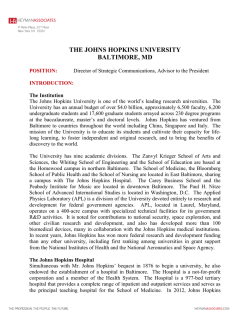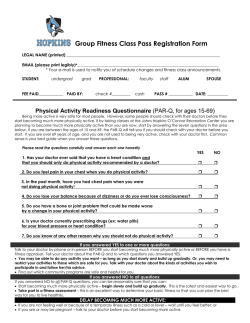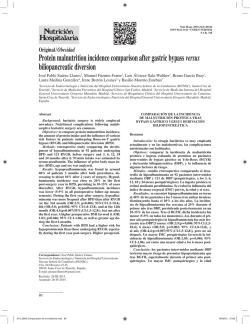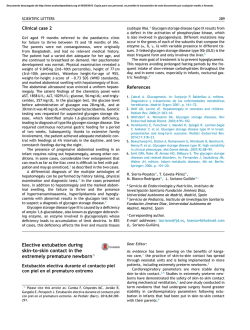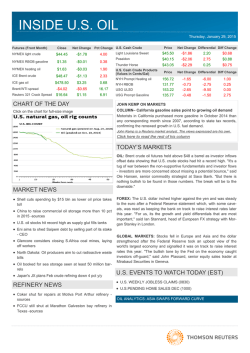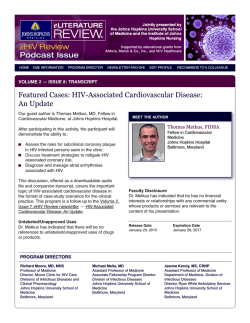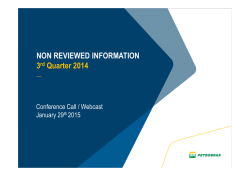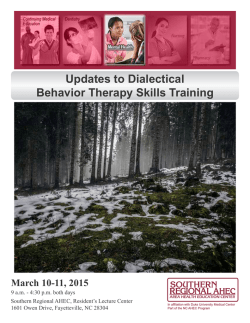
Download - eNeonatal Review
HOME NEWSLETTER ARCHIVE CME/CE INFORMATION PROGRAM DIRECTORS EDIT PROFILE eNeonatal Review VOLUME 10, ISSUE 3 RECOMMEND TO A COLLEAGUE Program Information CME/CE Info Accreditation Credit Designations Intended Audience Learning Objectives Internet CME/CE Policy Faculty Disclosure Disclaimer Statement Management of Bronchopulmonary Dysplasia and Respiratory Distress Syndrome In this Issue... The chronic lung disease of infancy, termed bronchopulmonary dysplasia (BPD), is one of the most common and serious complications of extreme premature birth. Current strategies to reduce the incidence of BPD primarily focus on reducing the postnatal injury inflicted on preterm infants' immature lungs. These include limiting exposure to invasive ventilation by increasing noninvasive ventilation, instituting caffeine therapy for apnea of prematurity, employing gentle ventilation techniques when invasive ventilation is required, and thoughtfully providing supplemental oxygen. Length of Activity 1.0 hour Physicians 1.0 contact hour Nurses Launch Date January 29, 2015 Expiration Date January 28, 2017 In this issue, we review recent studies that build on existing strategies by: clarifying the preferred approach to surfactant administration in preterm infants, identifying clinical benefits of noninvasive ventilation as a primary mode of respiratory support examining safe oxygen saturation ranges in preterm infants describing innovative research into the use of stem cell-based therapies to provide a potentially feasible and effective means of preventing BP Step 1. Review the CE Information and study the educational content. Step 2. Select a post-test link at the end of the newsletter. LEARNING OBJECTIVES After participating in this activity, the participant will demonstrate the ability to: Discuss the current role of exogenous surfactant therapy in the treatment of respiratory distress syndrome. Identify current therapeutic strategies targeted at reducing the incidence of bronchopulmonary dysplasia. Evaluate the emerging evidence for stem cell therapies as applies to the prevention of bronchopulmonary dysplasia. The Johns Hopkins University School of Medicine takes responsibility for the content, quality, and scientific integrity of this CME activity. Program Begins Below PLANNER DISCLOSURES As a provider approved by the Accreditation Council for Continuing Medical Education (ACCME), it is the policy of the Johns Hopkins University School of Medicine Office of Continuing Medical Education (OCME) to require signed disclosure of the existence of financial relationships with industry from any individual in a position to control the content of a CME activity sponsored by OCME. Members of the Planning TO ACCESS A POST-TEST • Lawrence M. Nogee, MD discloses that he has served as a contributor to UpToDate, Inc. No other planners have indicated that they have any financial interest or relationships with a commercial entity whose products or services are relevant to the content of their presentations. Step 3. Follow the instructions to access a post-test. Respiratory Therapists Please see the link at the end of this newsletter to confirm your state's acceptance of CE Credits. Committee are required to disclose all relationships regardless of their relevance to the content of the activity. Faculty are required to disclose only those relationships that are relevant to their specific presentation. The following relationship has been reported for this activity: IMPORTANT CME/CE INFORMATION GUEST AUTHORS OF THE MONTH Commentary & Reviews Bernard Thebaud, MD, PhD Professor of Pediatrics Children's Hospital of Eastern Ontario Ottawa, Ontario Canada Lannae Strueby, MD, FRCPC Clinical Assistant Professor Neonatology Royal University Hospital Saskatoon, Saskatchewan Canada Guest Faculty Disclosure Dr. Thebaud and Dr. Strueby have indicated that they have no financial interests or relationships with a commercial entity whose products or services are relevant to the content of their presentation. Unlabeled/Unapproved uses Dr. Thebaud and Dr. Strueby have indicated that there will be no references to unlabeled/unapproved uses of drugs or products. Program Directors' Disclosures IN THIS ISSUE Program Directors COMMENTARY from our Guest Authors SELECTIVE SURFACTANT THERAPY FOR RDS IN PRETERM INFANTS NON-INVASIVE RESPIRATORY SUPPORT AT BIRTH FOR STABILIZATION OF PRETERM INFANTS DETERMINING THE OPTIMAL OXYGEN SATURATION TARGETS IN PRETERM INFANTS BALANCING THE USE OF POSTNATAL CORTICOSTEROID THERAPY FOR BPD Maureen Gilmore, MD Assistant Professor of Pediatrics Director of Neonatology Johns Hopkins Bayview Medical Center Baltimore, Maryland Edward E. Lawson, MD Professor of Pediatrics Chief, Division of Department of Pediatrics Johns Hopkins Children's Center Baltimore, Maryland Lawrence M. Nogee, MD Professor Department of Pediatrics – Neonatology Johns Hopkins University School of Medicine Baltimore, Maryland Mary Terhaar, DNSc, RN PRE-CLINICAL EVIDENCE SUPPORTING STEM CELLS AS A POTENTIAL THERAPY FOR BPD SAFETY AND EFFICACY OF MESENCHYMAL STROMAL CELLS FOR PREVENTION OF BPD Associate Professor Director, DNP Program Johns Hopkins University School of Nursing Baltimore, Maryland Anthony Bilenki, MA, RRT Director Respiratory Care/ECMO Services The Johns Hopkins Hospital Baltimore, Maryland COMMENTARY Neonatal respiratory distress syndrome (RDS) is a condition of respiratory insufficiency occurring in neonates, secondary to deficient or dysfunctional surfactant.1,2 Pulmonary surfactant lowers alveolar surface tension and aids in maintaining the functional residual capacity of the lung.2 Bronchopulmonary dysplasia (BPD) is a chronic respiratory condition primarily affecting infants born at the extremes of prematurity. BPD is defined clinically and multiple diagnostic criteria currently exist,3-5 creating significant variability in the reported incidence of BPD and presenting difficulties when comparing the effectiveness of potential therapies.6 The reported incidence of BPD is between 35% and 50% in infants born at less than 28 weeks.7-10 The management of these two neonatal conditions is closely entwined as they share common risk factors, and interventions prompted by RDS may alter the risk of BPD. Exogenous surfactant administration is an essential treatment in the effective management of RDS in preterm neonates. More than 30 randomized trials have been conducted and demonstrate that exogenous surfactant is effective at reducing the incidence of pneumothorax, as well as reducing neonatal mortality. Controversy still exists regarding the best surfactant preparation, optimal timing, and mode of administration.1 Early evidence suggested that prophylactic administration of surfactant was the preferable approach, compared to treating only infants with established RDS. Prophylactic surfactant reduced air leaks, mortality, and the combined outcome of BPD or death. However, these early studies did not include current practices involving stabilization of preterm neonates using continuous positive airway pressure (CPAP) and widespread use of antenatal steroids. Additionally, prophylactic surfactant and the required preceding intubation are not without risk and are not necessary in all very preterm infants.1,2 The (reviewed herein) meta-analysis by Rojas-Reyes and colleagues, which includes recent studies with high antenatal corticosteroid use and early CPAP, indicates that selective surfactant therapy is associated with reduced BPD and death in neonates, compared with prophylactic surfactant. Those caring for preterm neonates must now strive to find the balance between avoiding mechanical ventilation when feasible and providing exogenous surfactant as early as possible to preterm infants with RDS.1 BPD is a multifactorial disease process that is associated with long-term health consequences, including poor neurodevelopmental outcome and chronic respiratory conditions such as asthma and pulmonary hypertension. The paucity of effective therapies, with acceptable side effect profiles, has resulted in the incidence of BPD remaining unchanged or possibly increased in recent years. Current treatment strategies primarily attempt to reduce the post-natal injury inflicted on the premature lung.11 Caffeine is recognized as a standard of care in the treatment of apnea of prematurity and has been shown to reduce the incidence of BPD, likely by reducing exposure to positive pressure ventilation.12 Dexamethasone is an effective therapy for BPD, but it has been associated with adverse neurodevelopmental outcomes. The analysis by Doyle et al assists in identifying infants most likely to obtain a net benefit from postnatal corticosteroid therapy. Another approach to reducing lung injury in preterm neonates is the increased use of noninvasive ventilation as a primary mode of respiratory support. The reviewed article by Schmölzer et al supports the use of CPAP in the delivery room as a means to reduce the occurrence of BPD in preterm infants less than 32 weeks' gestation at birth. Lung injury secondary to oxidative stress is implicated in the pathogenesis of BPD, and researchers are attempting to identify the optimal postnatal oxygen saturation range for preterm neonates. Early studies indicated that a restricted approach to oxygen exposure was safe and beneficial in reducing the incidence of retinopathy of prematurity (ROP) and BPD. The meta-analysis by Saugstad and Aune provides further information by summarizing studies of low (85%-89%) vs high (91%-95%) oxygen saturation targeting in preterm neonates less than 28 weeks. While the authors did not discover a significant difference in the primary outcome of death or major disability at 18-24 months or in the secondary outcome of BPD, they identified a reduction in severe ROP and a concerning increased risk of mortality and necrotizing enterocolitis (NEC) in the low-targeted oxygen saturation group. This meta-analysis highlights important potential complications of targeting oxygen saturations less than 90% in infants born at less than 28 weeks' gestational age. BPD is one of the most common and serious complications of extreme premature birth. Survivors of preterm birth with BPD are at increased risk for long-term neurodevelopmental and pulmonary morbidity. Innovative strategies are needed, and stem cell-based therapies represent a promising and novel approach. Stem cell research and literature have expanded at rapidly over the past decade, with a variety of cell types undergoing exploration for therapeutic benefit.13 Mesenchymal stromal cells (MSC) have received particular attention as a potential new therapeutic intervention for BPD. Chang et al have published the first clinical trial demonstrating the feasibility of MSC therapy for BPD and providing evidence for the short-term safety of this therapy in preterm neonates. The authors intend to complete further clinical trials investigating the efficacy and safety of MSC transplantation for prevention of BPD. While results of these trials are anxiously awaited, ongoing research is required to elucidate the mechanisms by which MSCs function, and continued rigorous preclinical research is required to verify long-term safety. References 1. Sweet DG, Halliday HL, Speer CP. Surfactant therapy for neonatal respiratory distress syndrome in 2013. J Matern Fetal Neonatal Med. 2013;26 Suppl 2:27-29. 2. Bahadue FL, Soll R. Early versus delayed selective surfactant treatment for neonatal respiratory distress syndrome. Cochrane Database Syst Rev. 2012;11:CD001456. 3. Jobe AH, Bancalari E. Bronchopulmonary dysplasia. Am J Respir Crit Care Med. 2001;163(7):1723-1729. 4. Walsh MC, Wilson-Costello D, Zadell A, Newman N, Fanaroff A. Safety, reliability, and validity of a physiologic definition of bronchopulmonary dysplasia. J Perinatol. 2003;23(6):451-456. 5. Shennan AT, Dunn MS, Ohlsson A, Lennox K, Hoskins EM. Abnormal pulmonary outcomes in premature infants: Prediction from oxygen requirement in the neonatal period. Pediatrics. 1988;82(4):527-532. 6. Walsh MC, Yao Q, Gettner P, et al. Impact of a physiologic definition on bronchopulmonary dysplasia rates. Pediatrics. 2004;114(5):1305-1311. 7. Lee SK, Ye XY, Singhal N, et al. Higher altitude and risk of bronchopulmonary dysplasia among preterm infants. Am J Perinatol. 2013;30(7):601-606. 8. Natarajan G, Pappas A, Shankaran S, et al. Outcomes of extremely low birth weight infants with bronchopulmonary dysplasia: Impact of the physiologic definition. Early Hum Dev. 2012;88(7):509-15. 9. Shah PS, Sankaran K, Aziz K, et al. Outcomes of preterm infants < 29 weeks gestation over 10-year period in canada: A cause for concern? J Perinatol. 2012;32(2):132-138. 10. Jobe AH. What is BPD in 2012 and what will BPD become? Early Hum Dev. 2012;88, Suppl 2(0):S27-S28. 11. Strueby L, Thebaud B. Advances in bronchopulmonary dysplasia. Expert Rev Respir Med. 2014;Jun(3):327-338. 12. Schmidt B, Roberts RS, Davis P, Doyle LW, Barrington KJ, Ohlsson A, et al. Caffeine therapy for apnea of prematurity. N Engl J Med. 2006;354(20):2112-2121. 13. Kourembanas S. Stem cell-based therapy for newborn lung and brain injury: Feasible, safe, and the next therapeutic breakthrough? J Pediatr. 2014;164(5):954-956. back to top SELECTIVE SURFACTANT THERAPY FOR RDS IN PRETERM INFANTS Rojas-Reyes MX, Morley CJ, Soll R. Prophylactic versus selective use of surfactant in preventing morbidity and mortality in preterm infants. Cochrane Database Syst Rev. 2012;3:CD000510. View Journal Abstract View Full Article This recent Cochrane meta-analysis by Rojas-Reyes and colleagues compared the effect of prophylactic surfactant administration with selective surfactant therapy in very preterm infants. Infants in the selective surfactant group could be managed with or without early CPAP. Randomized trials enrolling preterm infants were eligible for inclusion. Prophylactic surfactant was defined as intubation, at birth, of infants at high risk of developing RDS for the purpose of giving surfactant therapy. Selective surfactant therapy was defined as the administration of surfactant only to infants requiring intubation and demonstrating signs of RDS. Eleven studies were identified; in the selective surfactant group, nine did not include the routine application of CPAP at birth, and two included routine stabilization with CPAP at birth. Variability in the definition of infants at high risk of developing RDS resulted in a range of gestational age cutoffs. Eight studies included infants with a maximum gestational age of 30 weeks, while three studies included infants up to a gestational age of 31 or even 32 weeks. All types of surfactant products were eligible. Six of the 11 studies reported on the outcome of BPD defined as the need for supplemental oxygen at 36 weeks postmenstrual age. The combined analysis identified a trend toward increased risk of BPD with prophylactic surfactant (RR: 1.13, 95% CI 1.00 to 1.28, I2 = 0%). Meta-analysis of the three studies reporting information on the combined outcome of BPD or death demonstrated an increased risk of BPD or death with prophylactic surfactant use (RR: 1.13; 95% CI: 1.02 to 1.25, I2 = 0%) and a number needed to harm of 17. Where studies with routine CPAP stabilization were included, no statistically significant differences were found for other important clinical outcomes such as PVL, ROP, NEC, sepsis, pneumothorax, and PDA. This meta-analysis suggests the preferred approach to surfactant therapy and the management of RDS is early stabilization of preterm infants on CPAP and administration of surfactant to only those infants requiring intubation. A separate recent Cochrane review comparing early vs delayed surfactant therapy in preterm neonates intubated for RDS demonstrated that early therapy decreases the risk of neonatal mortality, BPD, and acute pulmonary injury.1 There is increasing interest in less invasive methods of surfactant delivery as a means to provide early therapy but avoid risks associated with intubation and mechanical ventilation. The delivery of surfactant via a thin catheter to spontaneously breathing infants has been found to reduce the need for mechanical ventilation and reduce the rate of BPD.2-4 Further research into this and other less invasive methods of surfactant delivery is needed. References 1. Bahadue FL, Soll R. Early versus delayed selective surfactant treatment for neonatal respiratory distress syndrome. Cochrane Database Syst Rev. 2012;11:CD001456. 2. Gopel W, Kribs A, Hartel C, Avenarius S, Teig N, Groneck P, et al. Less invasive surfactant administration is associated with improved pulmonary outcomes in spontaneously breathing preterm infants. Acta Paediatr. 2014, Dec 4. doi: 10.1111/apa.12883. [Epub ahead of print] 3. Kanmaz HG, Erdeve O, Canpolat FE, Mutlu B, Dilmen U. Surfactant administration via thin catheter during spontaneous breathing: Randomized controlled trial. Pediatrics. 2013;131(2):e502-e509. 4. Gopel W, Kribs A, Ziegler A, Laux R, Hoehn T, Wieg C, et al. Avoidance of mechanical ventilation by surfactant treatment of spontaneously breathing preterm infants (AMV): An open-label, randomised, controlled trial. Lancet. 2011;378(9803):1627-1634. back to top NON-INVASIVE RESPIRATORY SUPPORT AT BIRTH FOR STABILIZATION OF PRETERM INFANTS Schmolzer GM, Kumar M, Pichler G, et al. Non-invasive versus invasive respiratory support in preterm infants at birth: systematic review and meta-analysis. BMJ. 2013;347:f5980 View Journal Abstract View Full Article The lungs of very premature infants are particularly vulnerable to injury from mechanical ventilation. The lack of effective pharmacologic therapies for BPD has prompted significant interest in the modification of known risk factors, including mechanical ventilation. Noninvasive ventilation, including nasal continuous positive airway pressure (CPAP), is increasingly being used in preterm neonates to stabilize functional residual capacity and improve lung compliance, with a goal of avoiding intubation and mechanical ventilation. For this 2013 report, Schmolzer and colleagues performed a systematic review and metaanalysis examining the use of nasal CPAP soon after birth for prevention of death or BPD in very preterm neonates. Eligible studies were randomized controlled trials comparing primary respiratory support with nasal CPAP vs intubation in preterm infants born less than 32 weeks gestation, and reporting the outcomes of death and BPD. BPD was defined as the need for supplemental oxygen or mechanical ventilation at 36 weeks' corrected gestational age. Four studies, including a total of 2780 infants, satisfied the inclusion criteria. None of the studies were blinded, as the type of intervention is not conducive to blinding. There were no significant differences between the nasal CPAP and intubation groups with respect to birth weight and gestational age. Infants treated with nasal CPAP were significantly less likely to require mechanical ventilation (RR: 0.56; 95% CI: 0.32 to 0.97). Nasal CPAP as a primary mode of respiratory support at birth conferred a significant benefit in the combined outcome of BPD or death, or both (RR: 0.90; 95% CI: 0.83 to 0.98), with a number needed to treat of 25 and a borderline significant reduction in BPD alone (RR: 0.91; 95% CI: 0.81 to 1.01). Other secondary outcomes – including pneumothorax, postnatal corticosteroid use, PDA, NEC, grade III/IV IVH, and ROP – did not vary significantly between the nasal CPAP and intubation groups. Nasal CPAP as a primary mode of respiratory support, initiated in the delivery room, has the potential to reduce the outcome of death or BPD in very preterm infants. However, limitations to generalizing the results of this meta-analysis include variations in study design, inability to blind the intervention, and the requirement for antenatal consent (as this preselects for more stable pregnancies). Caution must be exercised when applying the results of this meta-analysis to infants less than 25 weeks' gestation, as there was very limited enrollment of infants in this population, which represents the highest-risk infants, who are most likely to require early intubation. back to top DETERMINING THE OPTIMAL OXYGEN SATURATION TARGETS IN PRETERM INFANTS Saugstad OD, Aune D. Optimal oxygenation of extremely low birth weight infants: a metaanalysis and systematic review of the oxygen saturation target studies. Neonatology. 2014;105(1):55-63. View Journal Abstract View Full Article A heightened awareness of the potential toxicity of oxygen has resulted in more cautious application of supplemental oxygen in neonates. It has also prompted questions regarding optimal oxygen saturation targets for preterm neonates in the NICU. In 2014, Saugstad and Aune completed a systematic review and meta-analysis comparing the effects of low vs high oxygen saturation targets in the postnatal period. Five multicenter, blinded, randomized controlled trials that assigned infants less than 28 weeks gestational age to either a low (85%-89%) or high (91%-95%) oxygen saturation target were included. These trials were the SUPPORT trial (Surfactant, Positive Pressure and Pulse Oximetry Trial), the three Benefits of Oxygen Saturation Targeting (BOOST) II trials, and the Canadian Oxygen Trial (COT). In total, 4,911 infants less than 28 weeks' gestation and less than 24 hours' age were enrolled in the five multicenter studies. No significant difference was identified in the incidence of BPD, defined as oxygen dependency at 28 days and the need for more than 30% oxygen or positive airway pressure at 36 weeks. However, the low-targeted oxygen saturation group demonstrated a reduced risk of severe ROP (RR: 0.74; 95% CI: 0.59 to 0.92) and a concerning increased risk of NEC (RR: 1.25; 95% CI: 1.05 to 1.49) and mortality (RR: 1.41; 95% CI: 1.14 to 1.74; I2 = 0%). Two studies (SUPPORT and COT) have published data on the composite outcome death or severe neurosensory disability at 18-24 months; analysis of these data show no significant difference between low and high saturation groups. Of note is that halfway through the BOOST II trial there was a change in the pulse oximeter software intended to improve oxygen saturation targeting. Following this change, an interim analysis identified increased mortality in the low-targeted oxygen saturation group, prompting early termination of two of the BOOST II trials. Based on these results, the authors suggest that oxygen saturation should be targeted at 90%-95% in infants born less than 28 weeks' gestation until they reach 36 weeks' postmenstrual age. It is important to note that these results differ from earlier metaanalyses addressing restricted vs liberal oxygen exposure in preterm or low birth weight infants, where it was concluded that restricted oxygen reduced the incidence and severity of ROP and BPD without increasing mortality. The studies included in the previous metaanalyses had highly variable definitions of restricted oxygen exposure and very few reported the outcome of mortality.1,2 References 1. Askie LM, Henderson-Smart DJ, Ko H. Restricted versus liberal oxygen exposure for preventing morbidity and mortality in preterm or low birth weight infants. Cochrane Database Syst Rev. 2009;(1):CD001077. 2. Saugstad OD, Aune D. In search of the optimal oxygen saturation for extremely low birth weight infants: A systematic review and meta-analysis. Neonatology. 2011;100(1):18. back to top BALANCING THE USE OF POSTNATAL CORTICOSTEROID THERAPY FOR BPD Doyle LW, Halliday HL, Ehrenkranz, et al. An update on the impact of postnatal systemic corticosteroids on mortality and cerebral palsy in preterm infants: effect modification by risk of bronchopulmonary dysplasia. J Pediatr. 2014;165:1258-60. View Journal Abstract View Full Article Controversy surrounds the use of systemic corticosteroids to prevent or treat BPD in preterm infants. Dexamethasone has demonstrated efficacy in reducing the incidence of BPD, but an association with an increased risk of adverse neurodevelopmental outcome often limits clinical use.1 As both BPD and postnatal corticosteroid use are linked to adverse neurologic outcome, the risk/benefit ratio of corticosteroid therapy may vary with an infant's risk of developing BPD. Doyle and colleagues have reexamined the relationship between BPD, postnatal corticosteroid therapy, and the outcome of death or cerebral palsy (CP). Twenty randomized controlled trials were included in their analysis, and a negative relationship between the risk difference for death or CP and the rate of BPD in the control group was identified (P = 0.008). This relationship is consistent with the authors' previous analysis, published in 2005, of data from 14 randomized controlled trials available at that time.2 This relationship indicates that infants with the highest risk for BPD may benefit from postnatal corticosteroid therapy with respect to survival free of CP. The authors conclude that this information may help guide clinicians in the use of postnatal corticosteroids, as the clinician could attempt to establish an infant's baseline risk of BPD and use the regression equation to determine if therapy is likely to have a net benefit. References 1. Halliday HL, Ehrenkranz RA, Doyle LW. Late (>7 days) postnatal corticosteroids for chronic lung disease in preterm infants. Cochrane Database Syst Rev. 2009; (1):CD001145. 2. Doyle LW, Halliday HL, Ehrenkranz RA, Davis PG, Sinclair JC. Impact of postnatal systemic corticosteroids on mortality and cerebral palsy in preterm infants: Effect modification by risk for chronic lung disease. Pediatrics. 2005;115(3):655-61. back to top PRE-CLINICAL EVIDENCE SUPPORTING STEM CELLS AS A POTENTIAL THERAPY FOR BPD O'Reilly M, Thébaud B. The promise of stem cells in bronchopulmonary dysplasia. Semin Perinatol. 2013; 37(2):79-84 View Journal Abstract View Full Article Stem cells are undifferentiated cells that are capable of self-renewal and have the capacity to differentiate into a variety of cell types. Research indicates that the lung possesses populations of multipotent endogenous stem cells, including distal lung epithelial stem cells, lung mesenchymal stromal cells (MSCs), and lung endothelial progenitor cells (EPCs). Recent animal and human studies link depletion or dysfunction of endogenous stem cells in the immature lung to the pathogenesis of BPD. This link has provided the foundation for ongoing investigation of stem cell supplementation as a means to prevent or repair injury to the immature lung. The therapeutic potential of reparative cells — including EPCs, MSCs and amnion epithelial cells — has been investigated in animal models of BPD and shown to confer benefits. MSCs are the most extensively studied cell type in relation to their therapeutic potential for BPD. MSCs can be obtained from the bone marrow, umbilical cord blood, umbilical cord, Wharton jelly, placenta, and adipose tissue. In animal models of BPD, the administration of MSCs have ameliorated lung inflammation, fibrosis, lung vascular damage, and alveolar growth impairment, thereby improving lung function and exercise tolerance. In preclinical studies, MSCs have demonstrated low engraftment rates in the lung, implying that their therapeutic benefits are mediated by a paracrine mechanism. Supporting the theory of paracrine-mediated effects are studies demonstrating that the conditioned media from MSCs prevents oxygen-induced alveolar simplification, protects alveolar epithelial and microvasculature endothelial cells from oxidative stress, and promotes a subset of endogenous stem cell to aid in lung repair.1 A growing body of evidence supports the use of stem cell-based therapies for BPD. However, safe clinical translation depends on continued rigorous preclinical research to investigate long-term outcomes of cell therapies and identify the optimal cell type and origin, as well as to determine the preferred dose and route of administration. Identifying these data will be important to standardizing approaches to stem cell definition, isolation, expansion, and manufacturing. Reference 1. Fung ME, Thebaud B. Stem cell-based therapy for neonatal lung disease: it is in the juice. Pediatr Res. 2014 Jan;75(1-1):2-7 back to top SAFETY AND EFFICACY OF MESENCHYMAL STROMAL CELLS FOR PREVENTION OF BPD Chang YS, Ahn SY, Yoo HS, et al. Mesenchymal stem cells for bronchopulmonary dysplasia: Phase 1 dose-escalation clinical trial. J Pediatr. 2014;164:966-72. View Journal Abstract View Full Article MSC-based therapies for BPD recently crossed the barrier from preclinical to clinical trials with the first published study using MSCs as a therapy for BPD in neonates. Chang et al completed a clinical trial investigating the feasibility and safety of MSCs as a therapy for BPD. This open-label, phase I dose escalation trial of human umbilical cord blood-derived MSCs included nine premature infants born between 23 and 29 weeks' gestational age. Infants 5-14 days of age were eligible for inclusion if they were requiring ventilation with a rate > 12 breaths/minute and supplemental oxygen > 25%. Treatment consisted of single intratracheal allogenic transplantation of human umbilical cord blood MSCs obtained from term infants and used within 24 hours of manufacturing. The first three infants received a low dose of 1 x 107 cells/kg; when no dose-limiting toxicity occurred, the next six infants received a high dose of 2 x 107 cells/kg. Dose-limiting toxicity was defined as death within six hours of MSC therapy or anaphylactic shock related to MSC therapy. Adverse outcomes of the treatment group were compared with a cohort of historical casematched infants. The transplantation procedure was well tolerated by all patients. Six infants subsequently developed serious adverse events (SAEs) that were not attributed to the MSC therapy: PDA requiring ligation, pneumothorax related to PDA ligation, NEC requiring surgery, PVL, and ROP ≥ stage 3. There were no significant differences in the frequency of SAEs between MSC treated infants and historical controls, with the exception of a reduction in the severity of BPD in treated infants. Interestingly, the group of infants treated with high-dose MSCs appeared to have a longer, although not statistically significant, duration of ventilation when compared to the low-dose group. The primary objective of this study was to examine the safety and feasibility of MSC therapy for BPD in high-risk premature neonates; conclusions about the effect of this therapy on the severity of BPD cannot be made. Although the stated study population included premature neonates at high-risk of BPD, the ventilation criteria specified could be considered conservative in many neonatal intensive care units, potentially reflecting a lower-risk population. While this likely would not alter the primary safety/feasibility outcome, it may skew the risk-benefit ratio of an investigational therapy in premature neonates. The authors conclude that intratracheal MSC therapy is safe and feasible, thus warranting further studies. These investigators are proceeding with a phase II randomized, doubleblinded, multicenter, controlled trial using an intratracheal transplantation of human umbilical cord blood-derived MSCs at the low dose (1 x 107 cells/kg) for treatment of BPD in premature infants. A sample size of 70 infants is targeted for the primary outcome of moderate to severe BPD or mortality at 36 weeks' CGA.1 Long-term follow-up studies of infants enrolled in both the phase I and phase II trials are planned. Infants in the phase I trial will be followed to 21 +/- 3 months CGA, while infants in the phase II trial will be followed to 60 months CGA.2,3 References 1. Clinicaltrials.gov. Efficacy and safety evaluation of pneumostem versus a control group for treatment of BPD in premature infants. Medipost Co Ltd. Available from: https://clinicaltrials.gov/ct2/show/NCT01828957?term =BPD+pneumostem&%20rank=1 2. Clinicaltrials.gov. Follow-up study of safety and efficacy of pneumostem in premature infants with bronchopulmonary dysplasia. Samsung Medical Center. Available from:https://www.clinicaltrials.gov./ct2/show/NCT01632475?term=%20BPD+and+ Pneumostem&rank=2 3. Clinicaltrials.gov. Follow-up safety and efficacy evaluation on subjects who completed pneumostem phase II clinical trial. Medipost Co. Ltd. Available from: https://clinicaltrials.gov/ct2/show/NCT01897987 back to top IMPORTANT CME/CE INFORMATION ACCREDITATION STATEMENTS Physicians This activity has been planned and implemented in accordance with the Essential Areas and Policies of the Accreditation Council for Continuing Medical Education through the joint providership of the Johns Hopkins University School of Medicine and the Institute for Johns Hopkins Nursing. The Johns Hopkins University School of Medicine is accredited by the ACCME to provide continuing medical education for physicians. Nurses The Institute for Johns Hopkins Nursing is accredited as a provider of continuing nursing education by the American Nurses Credentialing Center's Commission on Accreditation. CREDIT DESIGNATION STATEMENT Physicians eNewsletter: The Johns Hopkins University School of Medicine designates this enduring material for a STATEMENT OF NEED NUTRITION Physicians may not be aware of recent evidence-based recommendations on recognizing and treating GERD in neonates. • • Physicians may not be aware of recent evidence-based recommendations on recognizing and treating GERD in neonates. • Current neonatal nutritional management practices may be enhanced to optimize and meet the specific needs of low birth weight preterm infants. • Current neonatal nutritional management practices may be enhanced to optimize and meet the specific needs of low birth weight preterm infants. • Clinicians who treat neonates are uncertain of optimal strategies for prevention and early recognition and treatment of necrotizing enterocolitis. maximum of 1.0 AMA PRA Category 1 Credit(s)™. Physicians should claim only the credit commensurate with the extent of their participation in the activity. Podcast: The Johns Hopkins University School of Medicine designates this enduring material for a maximum of 0.5 AMA PRA Category 1 Credit(s)™. Physicians should claim only the credit commensurate with the extent of their participation in the activity. Nurses eNewsletter: This 1 contact hour educational activity is provided by the Institute for Johns Hopkins Nursing. Each newsletter carries a maximum of 1 contact hour or a total of 6 contact hours for the six newsletters in this program. Podcast: This 0.5 contact hour educational activity is provided by the Institute for Johns Hopkins Nursing. Each podcast carries a maximum of 0.5 contact hours or a total of 3 contact hours for the six newsletters in this program. There are no fees or prerequisites for this activity. RESPIRATORY-RELATED ISSUES Clinicians may be unfamiliar with some of the newest evidence-based approaches for treating neonatal persistent pulmonary hypertension. • • Clinicians treating preterm infants may not be fully aware of the most recent developments in optimal management of bronchopulmonary dysplasia and respiratory distress syndrome. CONFIDENTIALITY DISCLAIMER FOR CME CONFERENCE ATTENDEES I certify that I am attending a Johns Hopkins University School of Medicine CME activity for accredited training and/or educational purposes. I understand that while I am attending in this capacity, I may be exposed to "protected health information," as that term is defined and used in Hopkins policies and in the federal HIPAA privacy regulations (the "Privacy Regulations"). Protected health information is information about a person's health or treatment that identified the person. SUCCESSFUL COMPLETION To successfully complete this activity, participants must read the content, and then link to the Johns Hopkins University School of Medicine's website or the Institute for Johns Hopkins Nursing’s website to complete the post–test and evaluation. A passing grade of 70% or higher on the post-test/evaluation is required to receive CE credit. I pledge and agree to use and disclose any of this protected health information only for the training and/or educational purposes of my visit and to keep the information confidential. I agree not to post or discuss this protected health information, including pictures and/or videos, on any social media site (e.g. Facebook, Twitter, etc.), in any electronic messaging program or through any portable electronic device. LAUNCH DATE January 29, 2015; activities expire 2 years from the date of each publication. I understand that I may direct to the Johns Hopkins Privacy Officer any questions I have about my obligations under this Confidentiality Pledge or under any of the Hopkins policies and procedures and applicable laws and regulations related to confidentiality. The contact information is: Johns Hopkins Privacy Officer, telephone: 410-735-6509, email [email protected]. INTERNET CME POLICY The Office of Continuing Medical Education (CME) at the Johns Hopkins University School of Medicine is committed to protecting the privacy of its members and customers. The Johns Hopkins University SOM CME maintains its Internet site as an information resource and service for physicians, other health professionals, and the public. Continuing Medical Education at the Johns Hopkins University School of Medicine will keep your personal and credit information confidential when you participate in an Internet-based CME program. Your information will never be given to anyone outside of the Johns Hopkins University School of Medicine's CME program. CME collects only the information necessary to provide you with the services that you request. To participate in additional CME activities presented by the Johns Hopkins University School of Medicine Continuing Medical Education Office, please visit www.hopkinscme.edu. DISCLAIMER STATEMENT The opinions and recommendations expressed by faculty and other experts whose input is included in this program are their own. This enduring material is produced for educational purposes only. Use of the Johns Hopkins University School of Medicine name implies review of educational format design and approach. Please review the complete prescribing information of specific drugs or combination of drugs, including indications, contraindications, warnings, and adverse effects before administering pharmacologic therapy to patients. STATEMENT OF RESPONSIBILITY The Johns Hopkins University School of Medicine takes responsibility for the content, quality, and scientific integrity of this CME activity. "The Office of Continuing Medical Education at the Johns Hopkins University School of Medicine, as provider of this activity, has relayed information with the CME attendees/participants and certifies that the visitor is attending for training, education and/or observation purposes only." For CME Questions, please contact the CME Office (410) 955-2959 or email [email protected]. For certificates, please call (410) 502-9634. Johns Hopkins University School of Medicine Office of Continuing Medical Education Turner 20/720 Rutland Avenue Baltimore, Maryland 21205-2195 Reviewed & Approved by: General Counsel, Johns Hopkins Medicine (4/1/03) (Updated 4/09 and 3/14) INTENDED AUDIENCE The target audience (clinicians) for this initiative includes neonatologists, respiratory therapists, neonatal nurses, nurse practitioners, and other members of the NICU team. POLICY ON FACULTY AND PROVIDER DISCLOSURE As a provider approved by the Accreditation Council for Continuing Medical Education (ACCME), it is the policy of the Johns Hopkins University School of Medicine Office of Continuing Medical Education (OCME) to require signed disclosure of the existence of financial relationships with industry from any individual in a position to control the content of a CME activity sponsored by OCME. Members of the Planning Committee are required to disclose all relationships regardless of their relevance to the content of the activity. Faculty are required to disclose only those relationships that are relevant to their specific presentation. The following relationships have been reported for this activity: Guest Author Disclosures HARDWARE & SOFTWARE REQUIREMENTS Pentium 800 processor or greater, Windows 98/NT/2000/XP/7 or Mac OS 9/X, Microsoft Internet Explorer 5.5 or later, 56K or better modem, Windows Media Player 9.0 or later, 128 MB of RAM, sound card and speakers, Adobe Acrobat Reader, storage, Internet connectivity, and minimum connection speed. Monitor settings: High color at 800 x 600 pixels. All rights reserved - The Johns Hopkins University School of Medicine. Copyright 2015. This activity was developed in collaboration with DKBmed. COMPLETE THE POST-TEST Step 1. Click on link to download instructions for the posttest and evaluation Respiratory Therapists Visit this page to confirm that your state will accept the CE Credits gained through this program.
© Copyright 2025
